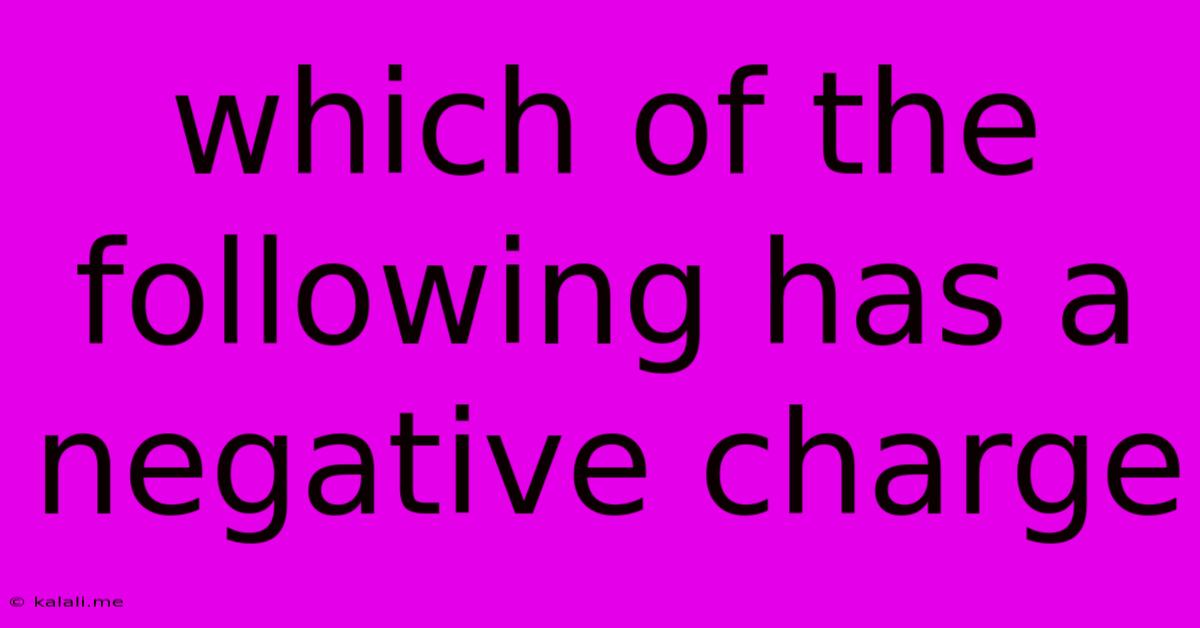Which Of The Following Has A Negative Charge
Kalali
Jun 13, 2025 · 2 min read

Table of Contents
Which of the Following Has a Negative Charge? Understanding Subatomic Particles and Ions
This article explores the concept of negative charge, focusing on subatomic particles and ions. Understanding which particles carry a negative charge is fundamental to comprehending basic chemistry and physics. We'll explore the key players: electrons, ions, and the role of protons and neutrons for context. Learn how these tiny particles dictate the electrical properties of matter.
Electrons: The Primary Carriers of Negative Charge
The most straightforward answer to the question "Which of the following has a negative charge?" is electrons. Electrons are fundamental subatomic particles that orbit the nucleus of an atom. They possess a single unit of negative electrical charge. This negative charge is a fundamental property, much like mass or spin. It's crucial to remember that the magnitude of this negative charge is exactly balanced by the positive charge of a proton.
Ions: Atoms with an Imbalance of Charge
While electrons are the primary carriers of negative charge, ions also play a crucial role. An ion is an atom or molecule that has gained or lost one or more electrons, resulting in a net electrical charge.
-
Anions: When an atom gains one or more electrons, it becomes negatively charged and is called an anion. The extra electrons outweigh the positive charge of the protons in the nucleus, resulting in a negative net charge. Examples include chloride ions (Cl⁻) and oxide ions (O²⁻).
-
Cations: Conversely, if an atom loses one or more electrons, it becomes positively charged and is called a cation. Cations have more protons than electrons, leading to a positive net charge. Examples include sodium ions (Na⁺) and calcium ions (Ca²⁺).
Protons and Neutrons: The Neutral and Positive Players
For completeness, let's briefly discuss protons and neutrons. Protons reside in the atom's nucleus alongside neutrons.
-
Protons: Protons carry a single unit of positive charge. This positive charge is equal in magnitude but opposite in sign to the charge of an electron.
-
Neutrons: Neutrons, as their name suggests, are electrically neutral. They have no charge.
Understanding Charge in Context
The presence or absence of electrons dictates the overall charge of an atom or molecule. A neutral atom has an equal number of protons and electrons, resulting in a net charge of zero. However, the addition or removal of electrons leads to the formation of ions with either a positive or negative charge. This charge imbalance is what drives many chemical reactions and physical phenomena.
In summary, while ions can carry a negative charge, the fundamental particle responsible for a negative charge is the electron. Understanding the behavior of electrons, protons, and neutrons is essential for grasping the fundamental principles of electricity and chemistry.
Latest Posts
Latest Posts
-
How Is Monopolistic Competition Similar To Perfect Competition
Jun 14, 2025
-
Correct The Following Sentences With Answers
Jun 14, 2025
-
Which Of The Following Is Not A Correctly Matched Pair
Jun 14, 2025
-
The Direction Of Natural Processes Is From States Of
Jun 14, 2025
-
What Is The Least Common Multiple Of 12 And 22
Jun 14, 2025
Related Post
Thank you for visiting our website which covers about Which Of The Following Has A Negative Charge . We hope the information provided has been useful to you. Feel free to contact us if you have any questions or need further assistance. See you next time and don't miss to bookmark.